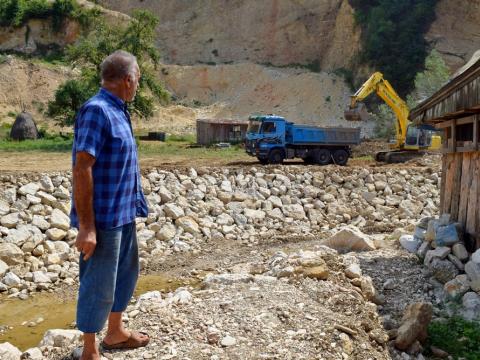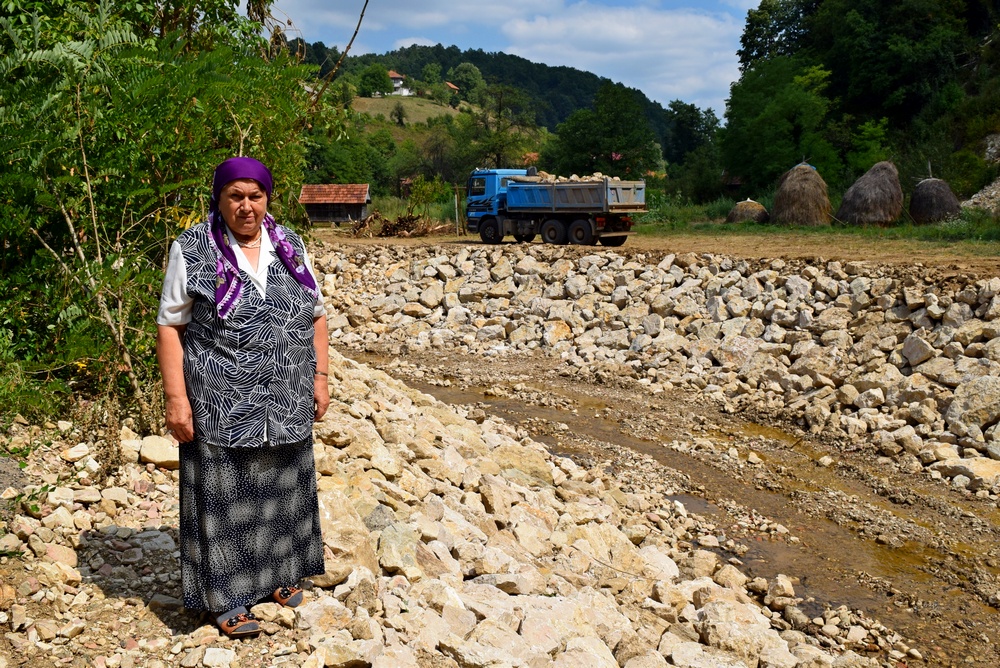Cleared streams minimise the risk of flooding in communities

'It did not rain that day at all. It was a day just like this one', Džemila points to the almost clear sky, trying to emphasise how unexpected and shocking it was when the floods happened. 'The water suddenly burst in. We heard the torrent coming from the hill, loudly dragging the stones with it', she continues. 'It all flooded.'
The picturesque area that surrounded Džemila's home changed in a second more than three years ago when record-breaking floods, the worst in over a century, hit Bosnia and Herzegovina.
Džemila's house, only few meters away from a small stream, flooded together with the houses of her neighbours. They were amongst 1.5 million people directly affected by the disaster. Almost 90,000 people had to leave their homes. Despite the incoming water, Džemila stayed. 'We could not leave the house for three days', she remembers.
'It did not rain that day' Rukib, Džemila's neighbour, repeats her words, as still in shock and disbelief. 'Water took everything from our ground floor. We had more than 3,000 shoes that we were planning to re-sell' he says. His family lost their entire livelihood that day.
Although three years passed since the disaster, families still worry that it might occur again. The sky is bright and the sun shines, but people still remember how it did not rain that day.
‘See how the water is near’ warns Džemila pointing to the small stream that runs slowly, well inside its banks.
In order to alleviate this fear, but also to prevent possible future disasters from happening, Džemila's community participated in the project 'Local Level Action for Sustainable Recovery'. The project aimed to support sustainable recovery of flood-affected communities in Bosnia and Herzegovina. The project is financed by the European Union and underway in five municipalities (Gračanica, Petrovo, Lukavac, Srebrenik and Kalesija) which are inhabited by 180,000 citizens.
As part of the project, the bank of the stream near Džemila's house is being cleared from debris, while its banks have been fortified.
'Clearing the stream and its banks is of extreme importance in flood prevention. Clear streams and water channels can accept larger amounts of water and take them away from inhabited areas’ says Sveto Đurđević, World Vision project manager. ‘The situation of the areas where we are working now was alarming: where the water runs, there were obstructions. The water ways were narrowed, filled-in with land and rocks, as well as various waste’, he explains adding that local experts assessed that this condition was a threat to the normal water flow, raising the risk of floods.
Besides the clearing of beds and banks along minor streams and waterways the project also included reforestation, clearance of drainage channels, and the distribution of fertiliser as a way of rehabilitating the soil, all in accordance with the specific needs of local community. In addition, networks for flood risk reduction were established at local levels where World Vision educated relevant stakeholders so that they have capacities, knowledge and skills to help prevent and also respond effectively to possible disasters in the future. Meetings in local communities across the five municipalities are being held, where residents are learning about the active role they can play to ensure their homes and livelihoods are less vulnerable to floods and other disasters.
When Džemila looks at her little stream, she still feels uneasy, although the works on clearing the waterway are progressing. ‘I’m afraid that the water will again take away everything.’ Just across her house, she rebuilt a little shack where she stores her winter necessities. ‘I have put coal in it. If it wasn’t for the coal in the shack, I would be less worried. Water can take away the shack, but not the coal. It’s too expensive. God forbid!’
But, when her stream is cleared and its banks fortified, Džemila can be sure that the risk of her losing her valuable livelihood has been brought to minimum.
